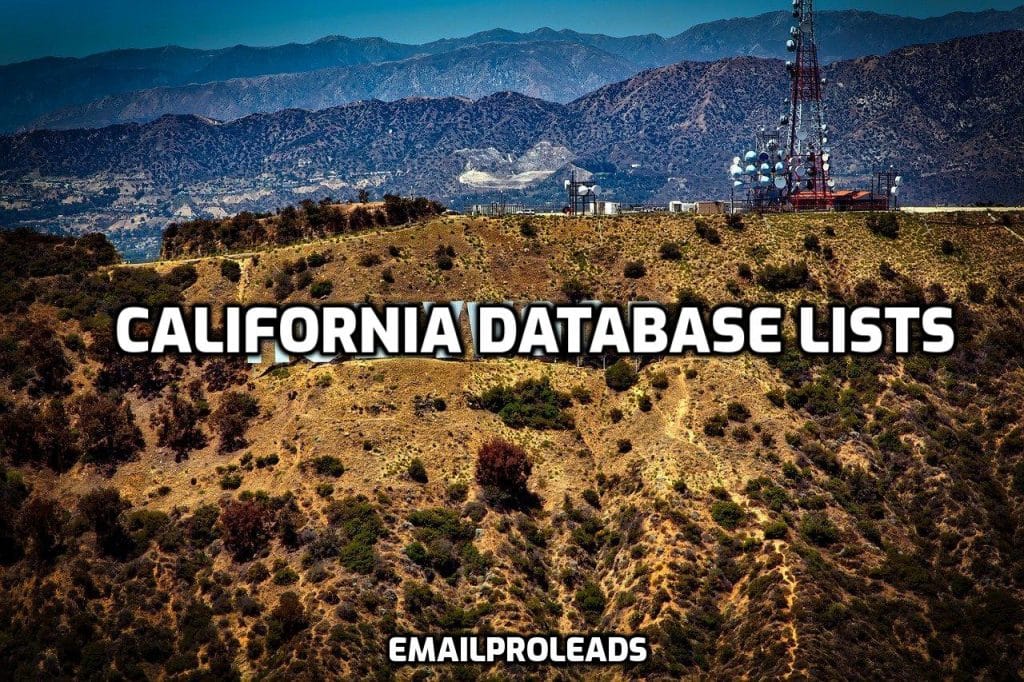The #1 site to find California Database Lists and accurate B2B & B2C email lists. Emailproleads.com provides verified contact information for people in your target industry. It has never been easier to purchase an email list with good information that will allow you to make real connections. These databases will help you make more sales and target your audience. You can buy pre-made mailing lists or build your marketing strategy with our online list-builder tool. Find new business contacts online today!
Just $199.00 for the entire Lists

Customize your database with data segmentation
- Job Titles
- Job Function
- Company Size
- Revenue Size
- SIC Codes
- NAICS Codes
- Geographics
- Technology
- And more...

Free samples of California Database Lists
We provide free samples of our ready to use California Database Lists. Download the samples to verify the data before you make the purchase.


Human Verified California Database Lists
The data is subject to a seven-tier verification process, including artificial intelligence, manual quality control, and an opt-in process.
Best California Database Lists
Highlights of our California Database Lists
First Name
Last Name
Phone Number
Address
City
State
County
Zip
Age
Income
Home Owner
Married
Property
Networth
Household
Cradit Rating
Dwelling Type
Political
Donor
Ethnicity
Language Spoken
Email
Latitude
Longitude
Timezone
Presence of children
Gender
DOB
Birth Date Occupation
Presence Of Credit Card
Investment Stock Securities
Investments Real Estate
Investing Finance Grouping
Investments Foreign
Investment Estimated
Residential Properties Owned
Traveler
Pets
Cats
Dogs
Health
Institution Contributor
Donates by Mail
Veteranin Household
Heavy Business
Travelers
High Tech Leader
Smoker
Mail Order Buyer
Online Purchasing Indicator
Environmental Issues Charitable Donation
International Aid Charitable Donation
Home Swimming Pool
Look at what our customers want to share





FAQ
Our email list is divided into three categories: regions, industries and job functions. Regional email can help businesses target consumers or businesses in specific areas. California Database Lists broken down by industry help optimize your advertising efforts. If you’re marketing to a niche buyer, then our email lists filtered by job function can be incredibly helpful.
Ethically-sourced and robust database of over 1 Billion+ unique email addresses
Our B2B and B2C data list covers over 100+ countries including APAC and EMEA with most sought after industries including Automotive, Banking & Financial services, Manufacturing, Technology, Telecommunications.
In general, once we’ve received your request for data, it takes 24 hours to first compile your specific data and you’ll receive the data within 24 hours of your initial order.
Our data standards are extremely high. We pride ourselves on providing 97% accurate California Database Lists, and we’ll provide you with replacement data for all information that doesn’t meet your standards our expectations.
We pride ourselves on providing customers with high quality data. Our California Database Database and mailing lists are updated semi-annually conforming to all requirements set by the Direct Marketing Association and comply with CAN-SPAM.
California Database Lists
Emailproleads.com is all about bringing people together. We have the information you need, whether you are looking for a physician, executive, or California Database Lists. So that your next direct marketing campaign can be successful, you can buy sales leads and possible contacts that fit your business. Our clients receive premium data such as email addresses, telephone numbers, postal addresses, and many other details. Our business is to provide high-quality, human-verified contact list downloads that you can access within minutes of purchasing. Our CRM-ready data product is available to clients. It contains all the information you need to email, call, or mail potential leads. You can purchase contact lists by industry, job, or department to help you target key decision-makers in your business.
If you’re planning to run targeted marketing campaigns to promote your products, solutions, or services to your database, you’re at the right spot. Emailproleads dependable, reliable, trustworthy, and precise California Database List lets you connect with key decision-makers, C-level executives, and professionals from various other regions of the country. The list provides complete access to all marketing data that will allow you to reach the people you want to contact via email, phone, or direct mailing.

Our pre-verified, sign-up Email marketing list provides you with an additional advantage to your networking and marketing efforts. Our database was specifically designed to fit your needs to effectively connect with a particular prospective customer by sending them customized messages. We have a dedicated group of data specialists who help you to personalize the data according to your requirements for various market movements and boost conversion without trouble.
We gathered and classified the contact details of prominent industries and professionals like email numbers, phone numbers, mailing addresses, faxes, etc. We are utilizing the most advanced technology. We use trusted resources like B2B directories and Yellow Pages; Government records surveys to create an impressive high-quality Email database. Get the California Database today to turn every opportunity in the region into long-term clients.
Our precise Database Leads is sent in .csv and .xls format by email.
California Database Lists has many benefits:
Adestra recently conducted a survey to determine which marketing channel was the most effective return on investment (ROI). 68% of respondents rated email marketing as ‘excellent’ or ‘good.
California Database Leads can be cost-effective and accessible, which will bring in real revenue for businesses regardless of their budget. It is a great way for customers to stay informed about new offers and deals and a powerful way to keep prospects interested. The results are easy to track.
Segment your list and target it effectively:
Your customers may not be the same, so they should not receive the same messages. Segmentation can be used to provide context to your various customer types. This will ensure that your customers get a relevant and understandable message to their buying journey. This allows you to create personalized and tailored messages that address your customers’ needs, wants, and problems.

Segmenting your prospects list by ‘who’ and what is the best way to do so. What they’ve done refers to what they have done on your website. One prospect might have downloaded a brochure, while another person may have signed up for a particular offer. A good email marketing service will let you segment your list and automate your campaigns so that they can be sent to different customer types at the time that suits you best.
Almost everyone has an email account today. There will be over 4.1 billion people using email in 2021. This number is expected to rise to 4.6 billion by 2025. This trend means that every business should have an email marketing list.
California Database List is a highly effective digital marketing strategy with a high return on investment (ROI). Because millennials prefer email communications for business purposes, this is why.
How can businesses use email marketing to reach more clients and drive sales? Learn more.
California Database marketing has many benefits:
Businesses can market products and services by email to new clients, retain customers and encourage repeat visits. Database Lists marketing can be a great tool for any business.
High Conversions
DMA reports that email marketing has a $42 average return per $1. Email marketing is a great marketing strategy to reach more people and drive sales if you launch a promotion or sale.
You can send a client a special offer or a discount. California Database Lists can help automate your emails. To encourage customer activity, set up an automated workflow to send welcome, birthday, and re-engagement emails. You can also use abandoned cart emails to sell your products and services more effectively.
Brand Awareness
Database marketing allows businesses to reach qualified leads directly.
California Database will keep your brand in mind by sending emails to potential customers. Email marketing has a higher impact than social media posts because it is highly targeted and personalized.
Contrary to other channels, a business can send a lot of emails to large numbers of recipients at much lower costs.
Increase customer loyalty
One email per week is all it takes to establish unbreakable relationships with customers.
An email can be used to build customer loyalty, from lead-nurturing to conversion to retention and onboarding. A personalized email with tailored content can help businesses build strong customer relationships.
Tips for capturing email addresses
A business must have an email list to use email marketing. You will need a strategy to capture these email addresses.
California Database Lists will get your email campaigns off the ground with a bang!
We understand that reaching the right audience is crucial. Our data and campaign management tools can help you reach your goals and targets.
Emailproleads are a long-standing way to market products and services outside the business’s database. It also informs existing customers about new offerings and discounts for repeat customers.
We offer real-time statistics and advice for every campaign. You can also tap into the knowledge of our in-house teams to get the best data profile.
Your California Contact Database Lists marketing campaigns will feel effortless and still pack a punch. You can use various designs to highlight your products’ different benefits or help you write compelling sales copy.
Contact us today to order the Database marketing database to support your marketing. All data lists we offer, B2C and B2B, are available to help you promote your online presence.
We already have the database for your future customers. You will be one step closer when you purchase email lists from us.
Talk to our friendly team about how we can help you decide who should be included in your future email list.
The #1 site to find business leads and accurate California Database Leads. Emailproleads.com provides verified contact information for people in your target industry. It has never been easier to purchase an email list with good information that will allow you to make real connections. These databases will help you make more sales and target your audience. You can buy pre-made mailing lists or build your marketing strategy with our online list-builder tool. Find new business contacts online today!
Blog
California database list
Delete DATA IS a scam
One of the objectives in event-sourcing is preserve the past of the aggregates it deliberately keeps data for a long time. The most common method of deleting data employing event-based sourcing would be to perform an automatic deletion. A program deletes the aggregate using the flag to delete. The aggregate typically emits an event titled Deleted that alerts interested consumers. Any program that connects to that aggregate will be able to check the flag and respond accordingly.
The use of a soft delete is effective great for a variety of data. One challenge, however, is complying with the General Data Protection Regulation (GDPR), a European data protection and privacy regulation that grants individuals the right to erasure (https:// gdpr-info.eu/art-17-gdpr/). A program must be able to erase any personal data of the user like an email address. The problem of an application that relies on event sourcing is that an email address could be saved within the AccountCreated event or for the main key for an aggregate. The application has to somehow forget information about the user, without deleting the events. California Customers Contact database.

California quality lists
The encryption method is one that you can employ to address this issue. Every user has an encryption key that is kept in a separate table in a database. The application utilizes that encryption key to decrypt all occasions that contain the user’s personal details before saving the events in an event storage. If a user asks to erase their personal information then the application deletes the encryption key’s record out of the database table. Personal information of the user is effectively erased, since the information cannot be decrypted.
The encryption of events can solve most issues by erasing personal data. However, if one part of the user’s personal data, like the email address is being used as the aggregate identification, discarding the encryption key might not be enough. For instance the subsection 6.2 refers to an event database which has an entity table, which’s primary key is that of the aggregate ID. One option to solve this issue is to utilize the technique of pseudo-onymization, which replaces the email address by a UUID token and making it an aggregate ID. The application saves the connection to and the UUID token and email address inside a table in the database. When a user wants to erase their email address and the application removes the row that contains their email address from the table. This stops it from mapping their UUID in the future to an email address. The process of contacting the store’s event organizer is A TRIBULANT.
Imagine that you have to locate customers who have used up the credit limits. Since there isn’t a credit column and limit, you cannot create a the query SELECT * FROM CUSTOMER WHERE CREDIT_LIMIT is 0. Instead, you’ll have to write an even more complicated and possibly ineffective query with an nested SELECT for computing the credit limit by folding the events that establish the initial credit , and then altering it. In addition the NoSQL-based store generally only supports the primary key-based lookup. This means that you have to create query using the CQRS approach as described in chapter 7.
Incorporating an event store California Customers database
A program that makes use of event sourcing, stores their events within an event storage. Event stores are an amalgamation of both a database and a message broker. It functions as a database since it provides an API to insert and retrieve aggregated events using a primary key. It also functions as a message broker since it provides an API for subscribing events.
There are several methods to set up events stores. One possibility is to implement an event-based store using your own and framework for sourcing. For instance, you can add events to an RDBMS. An easy, but low-speed, method to publish events is to allow subscribers to check in the table EVENTS for any events. However, as mentioned in section 6.1.4 one challenge is to ensure that a subscriber process all events in a timely manner.
Another option is using an event store that is specifically designed for events that usually comes with many options and features, as well as more performance and scaling. There are a variety of them available to choose from:
Event Store–A .NET-based open source event store developed by Greg Young, an event sourcing pioneer
Lagom–A microservices framework developed by Lightbend, the company for-merly known as Typesafe (www.lightbend.com/lagom-framework). California business database
Axon–An open source Java framework for developing event-driven applications that use event sourcing and CQRS (www.axonframework.org).
Eventuate–Developed by my startup, Eventuate (http://eventuate.io). There are two variants of Eventuate: Eventuate SaaS, an online service and Eventuate Local which is an Apache Kafka/RDBMS open source project.

purchase California lists
Although the frameworks are different in terms of details however the basic concepts remain the same. Since Eventuate is the one I’m am most acquainted with, it’s the one I’ll discuss in this article. It’s a simple and easy-to-understand structure that demonstrates events sourcing concepts. It can be used in your applications, modify the concepts on your own or take the knowledge you’ve learned in this article to create applications using any of the other event frameworks for sourcing.
California mailing lists
The next section begins by explaining ways in which I explain how the Eventuate Local event store works. Then , I will explain how to use the Eventuate Client framework for Java frames-work that is easy to use for writing event-sourcing-based business logic that makes use of an Eventuate Local event store. email marketing database California
What is the Eventuate Local Event Store works
Eventuate Local is an open source event store. Figure 6.9 shows the design. Events are saved in a database like MySQL. Applications can insert and retrieve aggregated events using a the primary key. Applications take events received from a message broker like Apache Kafka. A tailing mechanism for transaction logs transmits data from the server to the messaging broker.
Let’s take a look at the various Eventuate Local components, starting with the schema for databases.
THE SCHEMA OF EVENTUAL’S EVENT DATABASE
The database of events is comprised from three tables.
events–Stores the events
entities. One row per entity
snapshots–Stores snapshots
The main table is the table of events. The layout that this table has is similar to the table illustrated on figure 6.2. This is its definition:
Table events can be created (
event_id varchar(1000) Primary Key,
event_type varchar(1000),
Event_data varchar(1000) not NULL
Entity_Type VARCHAR(1000) not NULL
Entity_ID VARCHAR(1000) not NULL
triggering_event VARCHAR(1000)
);
The triggering_event column can be used to find duplicate messages and events. It records an ID for the message or event which caused the event.
The table of entities stores the most current version of each entity. It is used to implement optimistic locking. Here’s the definition for this table:
create table entities California business leads database
Once an entity has been established, a row is added to this table. When an entity is changed, the column for entity_version is modified.
The snapshots table holds the snapshots of every entity. This is the definition of this table:
The columns entity_type and entity_id define the snapshot’s entity. The snapshot json column is the representation in a serialized format of the snapshot. the snapshot_type defines its type. The entity_version indicates which version of the entity the snapshot represents.

buy California targeted list
The three functions that are supported by this schema include find() (), create() and updates(). This() operation checks the snapshots table for the most recent snapshot, if there is one. If a snapshot is present then the search() operation will query the table of events to locate the events with an event_id greater than the snapshot’s version of the entity. In other words, find() returns all events associated with the entity. Find() function also query the table of entities to find the current version of the entity.
California lists
The Create() operation inserts a row in the entity table , and then inserts the event into the table of events. Update() operation inserts events into the table. It also performs an optimistic lock checking by updating an version of the entity in the table of entities with this UPDATE statement
UPDATE entities SET entity_version = email marketing database California
What is the entity_type ? and entity_id = and entity_version =?
This is a confirmation that the version remains unchanged as it was found by finding() procedure. The entity_version is also updated to reflect the updated version. It is an update() operation makes these updates inside the course of a transaction to ensure an atomicity.
We’ve seen the way Eventuate Local stores an aggregate’s snapshots and events Let’s look at how clients can subscribe to events through Eventuate Local’s event broker.
CONSUMING EVENTS BY SUBSCRIBING TO EVENT Local’s Event BROKER
Services consume events through subscribing to the event broker that is operated by Apache Kafka. The event broker provides one topic for every aggregate type. In chapter 3.3, a topic can be described as an unpartitioned message channel. This allows users to scale horizontally while conserving message ordering. The aggregate ID acts as a parti-tion key which ensures the order of events that are published by an aggregate. To take advantage of the aggregate’s events the service must subscribe to the aggregate’s subject.
Let’s look at the event relay as the link between the database of events as well as the broker for events.
THE EVENTUAL LOCAL EVENT RELAY PROPAGATES EVENTS FROM DataBASE to the MESSAGE BROKER
The event relay relays events that are inserted into the database of events to the event broker. It utilizes the possibility of tailing the transaction logs whenever it is possible , and also polls other databases. For instance it is possible to poll other databases. For instance, the MySQL variant of event relay employs the MySQL master/slave replication protocol. The event relay is connected to MySQL MySQL server as like an individual slave, and then examines the MySQL binlog, which records of the changes that are made by the database. The entries in the EVENTS table, which relate to specific events. They are uploaded to the relevant Apache Kafka topic. The event relay is not aware of other modifications.
The event relay runs as a separate process. To ensure that it restarts correctly it saves periodically the current location in the binlog, including offset and filename in an exclusive Apache Kafka topic. When it starts, it first locates the most recent recorded position in the topic. The event relay then begins taking a look at the MySQL binlog starting from that location.
It is comprised of the event database as well as a the message broker and event relay are the components of the store for events.
Let’s look at the framework that a Java application employs to access the store of events.
It is the Eventuate client framework is a client for Java
Eventuate is an Eventuate client framework allows developers to write event-sourcing-based applications that make use of Eventuate Local as the Eventuate Local events store. The framework, which is illustrated in figure-ure 6.10 is the basis to create aggregates based on event sourcing such as ser-vices, aggregates, along with event handlers.
The framework offers the base classes for aggregates, commands and events. The AggregateRepository is a class that can provide CRUD functions. Frame-work comes with an API for signing up to events.

buy California database for marketing
Let’s look at the details of each type of model that are shown in the figure 6.10.
DEFINING AGGREGATES WITH THE REFLECTIVEMUTABLECOMMANDPROCESSINGAGGREGATE CLASS
ReflectiveMutableCommandProcessingAggregate is the base class for aggregates. It’s a generic class which includes two types of parameters: one is the aggregate’s concrete class and the second one is the superclass for the aggregate’s commands classes. Like its name implies, it makes use of reflection to route commands and events to the appropriate method. Commands are routed to the process() method and events are sent are sent to be applied to an() procedure.
The Order class you saw earlier extends ReflectiveMutableCommandProcessing-Aggregate. This table outlines how to use the class Order.
Listing 6.3 The eventual version of the class Order
public class Order extends ReflectiveMutableCommandProcessingAggregate {
Public List process(CreateOrderCommand command)
public void apply(OrderCreatedEvent event)
www.EBooksWorld.ir
The implementation of an event store Implementing an event store California Consumer database.
California listing
The two type parameters passed to ReflectiveMutableCommandProcessingAggregate are Order and OrderCommand, which is the base interface for Order’s commands.
DEFINING AGGREGATE COMMANDS
The command classes for an aggregate have to extend an aggregate-specific base-interface, which in turn must expand the interface for Command. For instance the commands of the Order aggregate extend OrderCommand.
Public user interface OrderCommand extends Command California quality lists
the public class CreateOrderCommand implements OrderCommand
Its OrderCommand interface is a subset of Command and the CreateOrderCommand class expands OrderCommand.
Defining DOMAIN EVENTS
An aggregate’s events classes should be extended to the Event interface that is a marker inter-face that has no methods. It is also beneficial to create an interface that is common to all of the aggregate’s event classes, that extends Event for every aggregate’s event classes. For instance, here’s the definition of the OrderCreated event:
interface OrderEvent extends Event {
}
the public class order created extends the OrderEvent
The class for events that are created by OrderCreated extends OrderEvent which is the interface that is used to create the order aggregate’s event classes. This is because the OrderEvent Interface extends Event. California quality lists
CONCRETING, FINDING and UPDATING AGGREGATES Using the AGGREGATEREPOSITORY Class
The framework offers a variety of ways to build, discover and modify aggregates. The most effective approach, which I’ll describe here is to make use of an AggregateRepository. Aggregate-Repository can be described as a generic class that’s parametrized through the aggregate class as well as the base command class of the aggregate. It has three methods that can be overloaded:

California database for sale
Save ()–Creates an overall
Find ()–Finds in aggregate
Update ()–Updates and overall
It is important to note that the save () as well as the upgrade() method are especially useful because they can be used to encapsulate the boilerplate code needed for the creation and updating of aggregates. For example save() is the command object as a parameter, and executes the steps below:
Instantiates the aggregate by using its default constructor
Invokes the process() to take care of the command.
Apply the generated events by applying()
The generated events are saved in the store for events
This update() method is similar to the update(). It uses two parameters, an aggregate ID as well as an com-mand. It it performs the following actions:
The aggregate is retrieved from the store for events.
Invokes the process() to take care of the command. California quality lists
The generated events are applied by applying()
It saves the events that are generated in the store for events
The AggregateRepository class is mostly utilized by applications that make and modify aggregates as a result of external requests. For instance the following table demonstrates how OrderService makes use of an AggregateRepository in order to build an order.
Listing 6.4 OrderService makes use of an AggregateRepository
public class OrderService{
Private AggregateRepository orderRepository;
public OrderService(AggregateRepository orderRepository) {
this.orderRepository = orderRepository;
}
public EntityWithIdAndVersion createOrder(OrderDetails orderDetails) { return orderRepository.save(new CreateOrder(orderDetails));
}
}
OrderService is infected by an AggregateRepository to store orders. Its create() method invokes AggregateRepository.save() with a CreateOrder command.
ASSISTING TO DOMAINE EVENTS
It is also possible to use the Eventuate Client framework also provides an API to write event handlers. List-ing 6.5 illustrates an event handler to handle CreditReserved events. The @EventSubscriber annotation identifies an ID for the subscription that is durable. Events that are broadcast when the subscriber’s not running will be released as soon as it is launched. The annotation @EventHandlerMethod indicates this creditReserved() method as an event handler. California quality lists
Listing 6.5 An event handler for OrderCreatedEvent
@EventSubscriber(id=”orderServiceEventHandlers”)
public class OrderServiceEventHandlers {
@EventHandlerMethod
public void creditReserved(EventHandlerContext Ctx) {• CreditReserved Event is ctx.getEvent();
An event handler is an element of the type EventHandlerContext that contains the event’s metadata as well as the event itself.
We’ve now looked at how to write event-sourcing-based business logic with an Eventuate Client Framework, lets take a look at ways to apply the event sourcing business logic that is based on the sagas. purchase California lists
By bringing sagas, event sourcing and sagas together
Imagine that you’ve implemented one or more services utilizing event source. It is likely that you’ve created services similar to the one in the listing 6.4. If you’ve read the chapter 4, you’ll be aware that many services need to begin and take part in sagas. These are a series of local transactions to ensure consistency of data across services. For instance, Order Service uses a Saga to verify the validity of an Order. Kitchen Service, Consumer Service, and Accounting Service participate in the saga. Therefore, you need to integrate the sagas with event sourcing-based business logic.

California database providers
Event sourcing makes it simple to make use of choreography-based sagas. Participants exchange domain events generated through their aggregates. Each aggre-gate handles events through processing commands and producing new event. It is necessary to create the aggregates as well as the event handler class, which are updated to reflect the aggregates. California Consumer database
California leads
However, integrating the event sourcing-based business logic into orchestration-based sagas is more difficult. The reason is that the concept of a transaction may be very limitless. In the case of some events stores, an app may only update or create an aggregate, and then release the resultant event(s). However, each stage of a story is made up of several actions that have to be carried out in a synchronized manner:
Saga creation: A service that starts an saga must make or modify an aggregate, and create the orchestrator of the saga. For instance, an Order Service’s createOrder() procedure should make an aggregate of Order as well
Saga orchestration: A saga orchestrator must take in replies in a single atomic unit, change its state, and issue commands.
Saga participants — Saga participants, like Kitchen Service and Order Service need to atomically process messages to identify and eliminate duplicate messages and aggregates, as well as create or update them and send messages to reply.
Due to the mismatch between these needs and the capabilities of transaction in an online store the combination of orchestration-based sagas as well as event sourcing could lead to interesting issues.
One of the most important factors in determining the ability to integrate orchestration-based sagas based on event sourcing is whether the store makes use of an RDBMS or an NoSQL database. It is important to note that the Eventuate Tram saga framework described in chapter 4 as well as the base Tram mes-sending framework that is described in chapter 3 are based on the flexibility of ACID transactions that are provided through the RDBMS. The orchestrator for the saga and participants in the saga use ACID transactions to change their database and send messages. If the application is using an event store that is based on RDBMS, like Eventuate Local, then it could cheat and call the purchase California lists
Business logic development using event sourcing
Eventuate Tram saga framework and updates the event store in an ACID transaction. However, if the store is based on an NoSQL database, which isn’t able to be part of similar transactions as Eventuate Tram saga framework, it’s going to require another method.
Let’s take a review of some diverse scenarios and issues you’ll have to tackle:
The use of choreography-based dramas
A saga based on orchestration
Implementing an event-based saga that is sourced participant
Implementing Saga orchestrators with event source
The first step is to look at ways to create choreography-based sagas based on event sources.
The creation of sagas based on choreography using event sources
The fact that event sourcing is driven by events sources makes it very easy to develop sagas that are based on choreography. If an aggregate gets changed, it broadcasts an event. A handler for an event of another aggregate could consume this event to modify its aggregate. The framework for event sourcing automatically transforms each event handler into an immutable.
For instance chapter 4 explains how to set up Create Order Saga using cho-reography. ConsumerService, KitchenService, and AccountingService Subscribe to the events of the OrderService and reverse. Each service is equipped with an event handler that is similar to the one in the list 6.5. The event handler will update the aggre-gate associated with it, which releases a different event.
The choreography-based sagas and event sourcing are very compatible. Event sourcing provides the tools that sagas require, such as messaging-based IPC mes-sage de-duplication and atomic updates of message and state. Even though it’s a simple process the choreography-based sagas come with a few disadvantages. I’ll discuss drawbacks in chapter 4. But there’s an issue that is particular to events the sourcing.
The issue of using events to create Saga Choreography is they serve a dual function. Event sourcing makes use of events to indicate changes in state, but using events to perform choreography for sagas calls for an aggregate to generate an event even when there’s no change in state. In the case of the updating of an aggregate is in violation of the business rules, then the aggregate needs to issue an event to inform the user of the violation. A more serious issue occurs the case when a saga participant is unable to build an aggregate. There’s nothing in the aggregate that can produce an error.
Due to these types of problems, it’s recommended to develop more complex stories using orchestration. The next sections will explain how to incorporate orchestration-based sagas with event sources. As you’ll notice it’s about solving fascinating issues.

buy California database online
Let’s first look at how a service method such as OrderService.createOrder() cre-ates a saga orchestrator.
Create the Order total.
By bringing sagas, event sourcing and sagas together purchase California lists
The story is based on orchestration.
Saga orchestrators are made through a variety of service methods. Other service methods, such as OrderService.createOrder(), do two things: create or update an aggregate and create a saga orchestrator. The service has to execute both of these actions in a manner which guarantees that if it performs the first step, the second step will occur in the end. How the service can ensure that both actions are carried out depends on the type of event store it is using.
CONSTRUCTING A SAGA ORCHESTRATOR using an RDBMS-based event store
If a service utilizes an event store based on RDBMS that can be updated, it is able to update the event store and then create an orchestrator for saga inside the ACID transaction. Imagine, for instance, that the OrderService makes use of Eventuate Local and the Eventuate Tram saga framework. The creation() method could be like this: California database free
California Profile
Class OrderService
Make sure that your createOrder() executes
@Autowired in a database transaction. private SagaManager createOrderSagaManager;
Design the CreateOrderSaga.
It’s a blend with the OrderService in Listing 6.4 as well as it’s the OrderService that is described in Chapter 4. Since Eventuate Local uses an RDBMS it is able to take part within the exact ACID event as Eventuate Tram’s saga framework. However, if a service is an event store that’s based on NoSQL the process of creating an orchestrator for saga isn’t quite as easy.
CREATING A SAGA ORCHESTRATOR WHEN USING A NOSQL-BASED EVENT STORE
A service that relies on an event store based on NoSQL is most likely not able to atomically update the store, and also create an orchestrator for saga. The frame-work used to orchestrate sagas could utilize a different database. However, even if it is using the same NoSQL data-base, the program cannot create or update two distinct objects simultaneously due to the NoSQL database’s restricted transaction model. In order to be able to do this, the service needs include an event handler that produces the saga orchestrator response to an event that is generated from the aggregate.
One thing to keep in mind when creating an event handler to create a saga orchestrator is that it has to manage multiple events. A message delivered at least once means that an event handler which creates the saga could be called several times. It’s crucial to make sure that only one instance of the saga is created.
One approach is to deduce an ID of the saga by identifying one particular characteristic of the particular event. There are many possible options. One option is to utilize the aggre-gate’s ID that generates the event to be the saga’s ID. This is ideal for sagas created as a result of global creation events.
Another alternative is to use the event ID to create the saga ID. Since the event IDs are unique it is guaranteed that the saga ID will be unique. If the event is duplicated that is, the event han-dler’s effort in creating the saga won’t succeed due to the fact that it is likely that the ID has already been created. This is a good option in situations where multiple versions of the same story be found for an overall instance.
An application that makes use of an event store that is based on RDBMS can make use of the same approach to make stories. One benefit of this strategy is that it encourages loose coupling since services like OrderService are no longer required to explicitly initiate stories.

California id list
We’ve now looked at how to create a reliable orchestrator for a saga, let’s look at the ways that event sourcing services can take part in orchestration-based stories. buy California targeted list
Implementing an event-based saga that is sourced participant
Imagine you are using event sourcing to build an application that has to be part of the orchestration of a saga. This isn’t a surprise, especially when your service is using an event store that is based on RDBMS, like Eventuate Local, you can easily make sure that it processes commands from saga and also responds. It’s possible to update the store as part of an ACID transaction that is initiated through the Eventuate Tram framework. However, you’ll need an entirely different method when your service utilizes an existing event database that doesn’t be part of similar transactions as Eventuate Tram framework.
You need to address two problems:
Command message handling that is independant
Sending a message in a jiffy buy California targeted list
Let’s look at the first step in how to implement idempotent command messages handlers.
IDEMPOTENT COMMAND MESSAGE HANDLE
The first issue to resolve is how an event-sourcing-based program can recognize and eliminate duplicate messages to implement idempotent command messages handling. It is a fortunately easy issue to tackle with the mes-sage handling mechanism that we discussed earlier. The saga participant keeps the message ID in events that occur when handling the messages. Prior to updating an aggregate, the saga player confirms that it didn’t process the message prior to checking for the message ID within the events.
Atmically sending out Reply MeSSAGES
The other issue to be solved is how an event-sourcing-based player in saga can simultaneously send responses. In theory the saga orchestrator can join the events that are generated by aggregates, however there are two issues that arise with this method. The second issue is the fact that a saga request may not alter the status of an aggregate. In this scenario it is not possible for the aggregate to produce an event, and there won’t be a response to the saga orchestrator. Another issue is that this strategy will require the saga orchestrator be able to treat saga participants who utilize event sourcing in a different way from those who do not. In order to be able to receive events from domains the saga orchestrator needs to sign up to the aggregate’s events channel, in along with its own response channel. buy California targeted leads
An alternative is for the participant to continue sending an answer message to the saga orchestrator’s replies channel. However, rather than sending the reply directly, a saga player follows a two-step procedure: When an saga command handler is able to create and/or updates an aggregate it organizes for an SagaReplyRequested pseudo-event to be saved to the event store , along with the actual events generated through the aggregate.
The event handler that handles the SagaReplyRequested pseudo-event utilizes the information contained in the event to build the reply message. sends to the Saga orchestrator’s response channel. California database free
